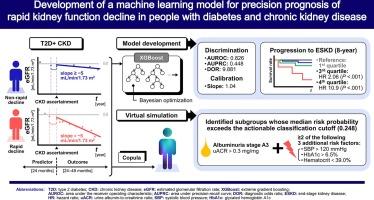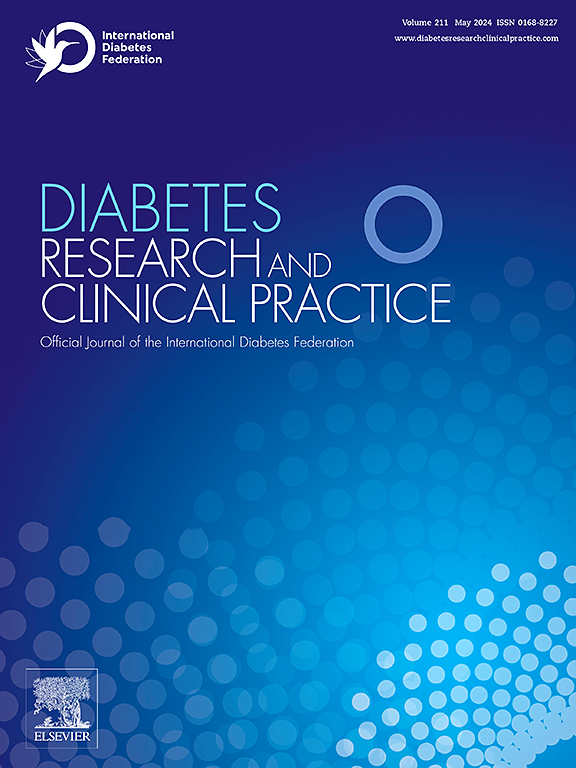针对糖尿病和慢性肾脏病患者肾功能快速衰退的精准预后开发机器学习模型。
IF 6.1
3区 医学
Q1 ENDOCRINOLOGY & METABOLISM
引用次数: 0
摘要
目的:开发一种机器学习模型,用于预测2型糖尿病(T2D)和慢性肾脏病(CKD)患者肾功能的快速衰退,并找出关键的可调整风险因素,以便采取有针对性的干预措施:我们对首尔国立大学医院的 6924 名 T2D 和 CKD 患者进行了回顾性队列研究。肾功能衰退通过估计肾小球滤过率斜率进行评估。通过模型诊断和时间-事件分析评估了极梯度提升(XGBoost)模型的性能。利用可改变的风险因素对风险亚组进行了Copula模拟分层:共有 906 人(13.1%)出现肾功能急剧下降。XGBoost 模型显示出最佳性能(接收器操作特征曲线下面积:0.826)。八年内患终末期肾病的风险在不同的风险四分位数之间呈上升趋势,其中第三季度(2.06;95% 置信区间 [CI]:1.29-3.29)和第四季度(10.9;95% 置信区间:7.36-16.2)的风险比具有显著的统计学意义。模拟分析确定了 A3 阶段白蛋白尿和以下至少两项的高风险亚组:血细胞比容 120 mmHg 和糖化血红蛋白 A1c >6.5 %:结论:XGBoost 模型通过 copula 仿真成功地对 T2D 和 CKD 患者的肾脏预后进行了分层。本文章由计算机程序翻译,如有差异,请以英文原文为准。

Development of a machine learning model for precision prognosis of rapid kidney function decline in people with diabetes and chronic kidney disease
Aims
To develop a machine learning model for predicting rapid kidney function decline in people with type 2 diabetes (T2D) and chronic kidney disease (CKD) and to pinpoint key modifiable risk factors for targeted interventions.
Methods
We conducted a retrospective cohort study on 6,924 individuals with T2D and CKD at Seoul National University Hospital. Kidney function decline was assessed using estimated glomerular filtration rate slopes. The performance of the eXtreme Gradient Boosting (XGBoost) model was evaluated through model diagnosis and time-to-event analyses. Copula simulation was conducted to stratify risk subgroups using modifiable risk factors.
Results
A total of 906 (13.1 %) individuals experienced rapid kidney function decline. The XGBoost model demonstrated optimal performance (area under the receiver operating characteristic curve: 0.826). The hazard of end-stage kidney disease within eight years increased across risk quartiles, with statistically significant hazard ratios in Q3 (2.06; 95 % confidence interval [CI]: 1.29–3.29) and Q4 (10.9; 95 % CI: 7.36–16.2). Simulation analysis identified high-risk subgroups by stage A3 albuminuria and at least two of the following: haematocrit < 39.0 %, systolic blood pressure > 120 mmHg, and glycated hemoglobin A1c > 6.5 %.
Conclusions
The XGBoost model, augmented by copula simulation, successfully stratified kidney prognosis in individuals with T2D and CKD.
求助全文
通过发布文献求助,成功后即可免费获取论文全文。
去求助
来源期刊

Diabetes research and clinical practice
医学-内分泌学与代谢
CiteScore
10.30
自引率
3.90%
发文量
862
审稿时长
32 days
期刊介绍:
Diabetes Research and Clinical Practice is an international journal for health-care providers and clinically oriented researchers that publishes high-quality original research articles and expert reviews in diabetes and related areas. The role of the journal is to provide a venue for dissemination of knowledge and discussion of topics related to diabetes clinical research and patient care. Topics of focus include translational science, genetics, immunology, nutrition, psychosocial research, epidemiology, prevention, socio-economic research, complications, new treatments, technologies and therapy.
 求助内容:
求助内容: 应助结果提醒方式:
应助结果提醒方式:


